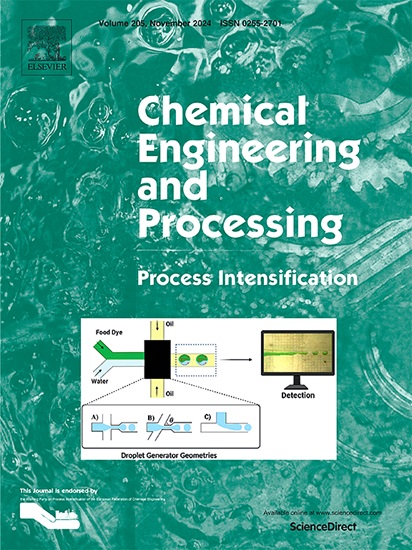Decarbonisation of cement industry: Calcium looping with white mud and limestone as CaO-based sorbents for industrial flue gas treatment
IF 3.8
3区 工程技术
Q3 ENERGY & FUELS
Chemical Engineering and Processing - Process Intensification
Pub Date : 2025-03-25
DOI:10.1016/j.cep.2025.110290
引用次数: 0
Abstract
This study investigates the potential of CaO-based sorbents from white mud and limestone for CO2 capture in the Calcium-looping (CaL) process, employing both dry synthetic gas and real industrial flue gas (FG) from a cement plant (<0.3 % moisture). Exploring white mud as a CO2 sorbent offers a novel way to valorise waste, aiding waste reduction. The CO2 capture capacity was evaluated in a laboratory scale Fluidized Bed Reactor over ten carbonation-calcination cycles (calcination: 930 °C, 70 % CO2; carbonation: 700 °C, 15 % CO2). Sorbents carbonated with FG demonstrated improved performance and stability, emphasizing moisture's role. These conditions generally improved sorbent textural properties after cycling. Results also showed that higher CO2 capture was associated with fresh sorbents having lower SiO2 content (<0.73 wt. %), whereas higher SiO2 content led to decreased performance. In conclusion, white mud offers potential for greener CO2 capture. The research further examines the potential for reducing calcination temperature when steam is used in both calcination-carbonation stages. Adding 15 vol. % steam was found to improve CO2 capture capacity at a lower calcination temperature (910 °C), achieving 0.29 g CO2/g sorbent in the first cycle. Our preliminary approach revealed that using steam during both stages is promising at low calcination temperatures.

水泥工业脱碳:用白泥和石灰石作为工业烟气处理中cao基吸附剂的钙环
本研究考察了白泥和石灰石中的cao基吸附剂在钙循环(CaL)过程中捕集二氧化碳的潜力,该过程使用了来自水泥厂的干燥合成气和真正的工业烟气(0.3%的水分)。探索白泥作为二氧化碳吸附剂提供了一种新的方式来评估废物,帮助减少废物。在实验室规模的流化床反应器中,通过10个碳化-煅烧循环(煅烧:930°C, 70% CO2;碳化:700°C, 15% CO2)。用FG碳化的吸附剂表现出更好的性能和稳定性,强调水分的作用。这些条件通常改善循环后吸附剂的结构性能。结果还表明,较高的CO2捕集率与较低SiO2含量(<0.73 wt. %)的新鲜吸附剂相关,而较高的SiO2含量导致性能下降。总之,白泥提供了更环保的二氧化碳捕获的潜力。该研究进一步考察了在煅烧-碳化两个阶段都使用蒸汽时降低煅烧温度的潜力。在较低的煅烧温度(910°C)下,添加15 vol. %的蒸汽可以提高CO2的捕集能力,在第一个循环中达到0.29 g CO2/g吸附剂。我们的初步方法表明,在较低的煅烧温度下,在两个阶段都使用蒸汽是有希望的。
本文章由计算机程序翻译,如有差异,请以英文原文为准。
求助全文
约1分钟内获得全文
求助全文
来源期刊
CiteScore
7.80
自引率
9.30%
发文量
408
审稿时长
49 days
期刊介绍:
Chemical Engineering and Processing: Process Intensification is intended for practicing researchers in industry and academia, working in the field of Process Engineering and related to the subject of Process Intensification.Articles published in the Journal demonstrate how novel discoveries, developments and theories in the field of Process Engineering and in particular Process Intensification may be used for analysis and design of innovative equipment and processing methods with substantially improved sustainability, efficiency and environmental performance.

 求助内容:
求助内容: 应助结果提醒方式:
应助结果提醒方式:


